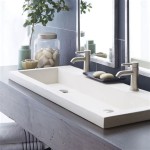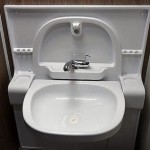Here is an article on how to replace a bathroom countertop:
How To Replace a Bathroom Countertop
Replacing a bathroom countertop is a common home improvement project that can significantly update the look and functionality of a bathroom. Whether the existing countertop is damaged, outdated, or simply not to the homeowner's taste, replacing it can be a cost-effective way to refresh the space. This article provides a comprehensive guide on how to successfully replace a bathroom countertop, outlining the necessary steps, tools, and considerations for a smooth and efficient installation.
Before beginning, it is crucial to consider the type of countertop material desired. Common options include laminate, solid surface (such as Corian), quartz, granite, marble, and tile. Each material has its own advantages and disadvantages in terms of cost, durability, maintenance, and aesthetic appeal. Researching and selecting the appropriate material is a key preliminary step. Furthermore, the dimensions of the existing countertop need to be accurately measured to ensure the new countertop will fit properly. It's also beneficial to consider any plumbing modifications that might be necessary, such as replacing the sink or faucet, as these should ideally be addressed concurrently.
Safety should always be a priority. Wearing appropriate safety gear, including eye protection and gloves, is essential throughout the removal and installation process. It is also important to disconnect the water supply to the sink before removing the old countertop to prevent water damage. For those unfamiliar with plumbing or electrical work, it is prudent to consult with a qualified professional.
Key Point 1: Removing the Existing Countertop
The first step in replacing a bathroom countertop is to carefully remove the existing one. This process requires patience and attention to detail to avoid damaging the surrounding cabinets or plumbing fixtures.
Shutting Off the Water Supply: Begin by turning off the water supply to the sink. Locate the shut-off valves under the sink and turn them clockwise until they are completely closed. Open the faucet briefly to relieve any residual water pressure in the lines. Place a bucket underneath the shut-off valves as small leaks are common even after the valves are closed.
Disconnecting the Plumbing: Disconnect the drainpipe from the sink drain. This usually involves loosening slip nuts with a wrench. Be prepared to catch any remaining water in the drainpipe with a bucket. Next, disconnect the water supply lines from the faucet. Again, a wrench will be needed for this step. Take care not to damage the supply lines, especially if they will be reused with the new faucet.
Removing the Sink: The method of sink removal depends on how the sink is attached to the countertop. Some sinks are held in place with clips and screws, while others are secured with adhesive caulk. If clips and screws are present, remove them. If the sink is caulked, use a utility knife to carefully score the caulk line where the sink meets the countertop. Gently pry the sink away from the countertop using a putty knife or similar tool. If the sink is heavy, enlist the help of another person to lift it out safely.
Detaching the Countertop: Most countertops are attached to the cabinet base with screws driven through the cabinet frame into the underside of the countertop. Locate these screws and remove them using a screwdriver or drill with a screwdriver bit. In some cases, the countertop may also be attached with adhesive. If adhesive is present, use a putty knife or pry bar to gently separate the countertop from the cabinet. Work slowly and carefully to avoid damaging the cabinets. If the countertop is heavy or large, consider having a helper assist with lifting.
Discarding the Old Countertop: Once the countertop is detached, carefully lift it off the cabinet base and remove it from the bathroom. Ensure the pathway is clear to avoid tripping or damaging anything. Dispose of the old countertop according to local regulations. Some materials may be recyclable, while others will need to be taken to a landfill.
Key Point 2: Preparing for the New Countertop Installation
With the old countertop removed, the next step is to prepare the cabinet base for the new countertop. This includes cleaning the surface, making any necessary repairs, and ensuring the cabinet is level and structurally sound.
Cleaning the Cabinet Base: Thoroughly clean the top of the cabinet base to remove any debris, dust, or remnants of the old countertop or adhesive. A vacuum cleaner and a damp cloth can be used for this purpose. Ensure the surface is clean and dry before proceeding.
Inspecting and Repairing the Cabinet: Inspect the cabinet base for any signs of damage, such as rot, water stains, or loose joints. Repair any damage before installing the new countertop. This may involve replacing damaged wood, tightening screws, or reinforcing weak areas with wood glue and clamps. Addressing these issues now will help ensure the new countertop is properly supported and will prevent future problems.
Leveling the Cabinet: Ensure the cabinet base is level. Use a level to check the surface in multiple directions. If the cabinet is not level, use shims to adjust the height. Place shims between the cabinet base and the floor until the surface is level. Once the cabinet is level, secure the shims in place with construction adhesive or small finishing nails.
Dry Fitting the New Countertop: Before permanently installing the new countertop, perform a dry fit to ensure it fits properly. Carefully place the countertop on the cabinet base and check for any gaps or misalignment. If necessary, make minor adjustments to the cabinet base or the countertop to achieve a perfect fit. Mark any areas that need to be trimmed or adjusted.
Key Point 3: Installing the New Countertop and Finishing Touches
The final step involves installing the new countertop, securing it to the cabinet base, and reconnecting the plumbing fixtures. This requires careful attention to detail and adherence to the manufacturer’s instructions for the chosen countertop material.
Applying Adhesive or Sealant: Depending on the countertop material and the manufacturer’s recommendations, apply adhesive or sealant to the top of the cabinet base where the countertop will rest. This will help secure the countertop and prevent it from shifting. For solid surface and stone countertops, a bead of silicone caulk is often used. For laminate countertops, construction adhesive may be more appropriate. Apply the adhesive or sealant evenly and according to the manufacturer’s instructions.
Positioning and Securing the Countertop: Carefully lift the new countertop and place it on the cabinet base. Ensure it is properly aligned and that there are no gaps or protrusions. Press down firmly on the countertop to ensure it is securely adhered to the cabinet base. Use clamps or weights to hold the countertop in place while the adhesive or sealant dries, if necessary.
Securing the Countertop with Screws: In addition to adhesive, most countertops should be secured to the cabinet base with screws. Locate the pre-drilled holes on the underside of the countertop or drill pilot holes through the cabinet frame into the underside of the countertop. Use screws of the appropriate length to secure the countertop to the cabinet base. Be careful not to overtighten the screws, as this could damage the countertop.
Installing the Sink and Faucet: Once the countertop is securely installed, install the sink and faucet according to the manufacturer’s instructions. Apply a bead of silicone caulk around the rim of the sink where it meets the countertop to create a watertight seal. Secure the sink to the countertop using the provided clips and screws. Connect the faucet to the water supply lines and tighten the connections with a wrench. Ensure that all connections are secure and leak-free.
Reconnecting the Plumbing: Reconnect the drainpipe to the sink drain. Tighten the slip nuts with a wrench to ensure a watertight seal. Turn on the water supply and check for leaks. If any leaks are present, tighten the connections or replace the fittings as needed. Allow the water to run for a few minutes to flush out any air in the lines.
Applying Caulk and Sealant: Apply a bead of caulk along the back edge of the countertop where it meets the wall. This will help prevent water from seeping behind the countertop and causing damage. Use a caulk smoothing tool or a wet finger to create a smooth, even bead. Also, apply sealant around the sink and faucet to create a watertight seal. Allow the caulk and sealant to dry completely before using the sink.
Final Inspection and Cleanup: Perform a final inspection of the installation to ensure that everything is properly aligned, secure, and leak-free. Clean up any debris or messes created during the installation process. Dispose of any waste materials properly. Once the installation is complete and the area is clean, the new bathroom countertop is ready to be used.
Replacing a bathroom countertop is a manageable DIY project with careful planning and execution. By following these steps and prioritizing safety, homeowners can achieve a professional-looking result and enhance the aesthetic appeal and functionality of their bathroom.

Replace Vanity Top And Faucet Diy Network

How To Replace A Bathroom Countertop Homeadvisor

Replace Granite Countertops Transform Your Bathroom S Look

How To Remove A Countertop From Vanity Decor Adventures

How To Remove Replace A Vanity Top Easy Bathroom Sink Remodel

How To Replace A Vanity Top And Save Craving Some Creativity

Diy Replace Vanity Top

Install A Solid Surface Bathroom Vanity Top Replace Countertop

It Has Grown On Me Replacing The Tile Vanity Top A Budget Bathroom Renovation

Diy Replace Vanity Top
Related Posts







